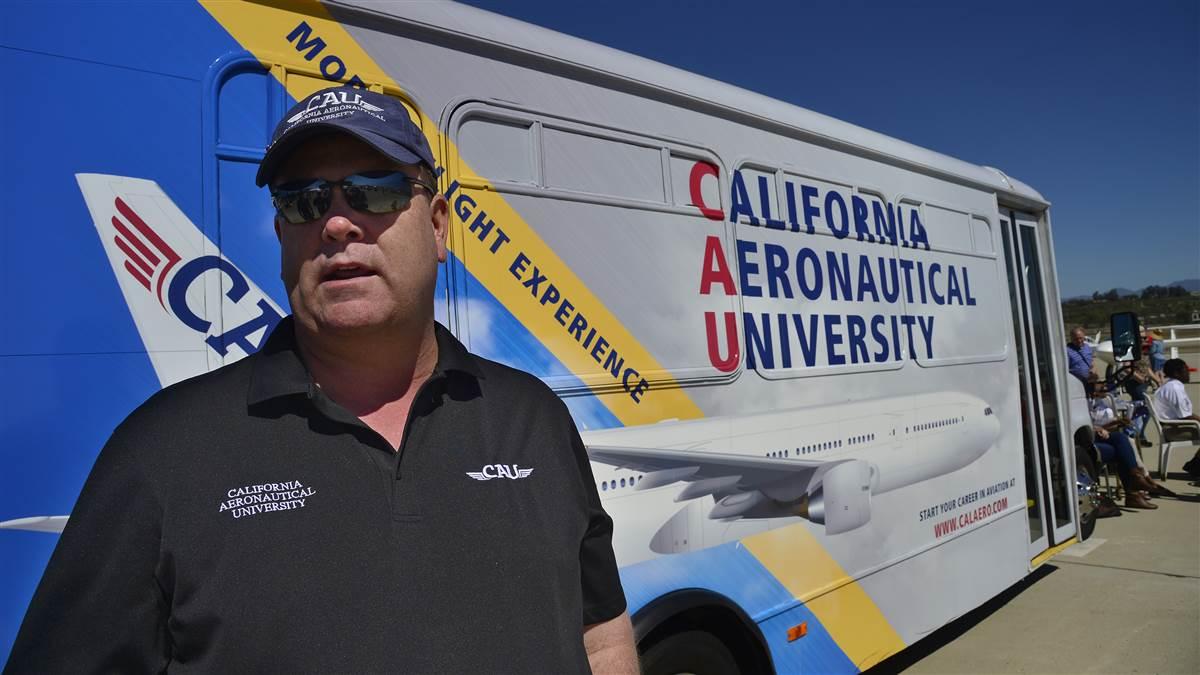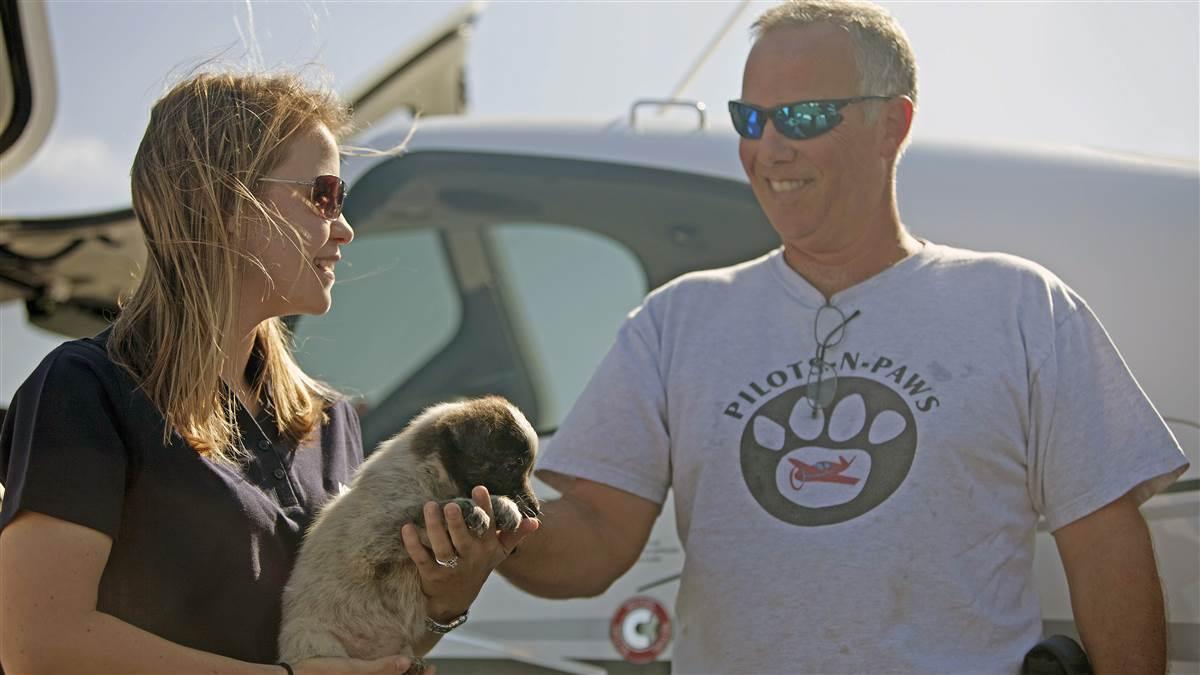
California Aeronautical University's Adia Smith tries her hand at a flight simulator inside the school's traveling classroom.
Mobile classroom is a hit
CAU students ‘live, sleep, and breathe aviation’
By David Tulis
 While students practiced approaches on a pair of flight simulators inside California Aeronautical University’s mobile classroom, school President Matt Johnson greeted guests and answered questions from the wind-swept Camarillo, California, airport ramp.
While students practiced approaches on a pair of flight simulators inside California Aeronautical University’s mobile classroom, school President Matt Johnson greeted guests and answered questions from the wind-swept Camarillo, California, airport ramp.
The blue-and-silver travel van adorned with a 20-foot-long depiction of a jet airliner sat at the ramp about one flight-hour south of the university’s pristine Bakersfield aviation campus. Overhead, CAU representative Vicki Benzing pierced the sky in her red 1940 Stearman biplane with the school’s logo displayed on its fuselage, drawing further attention to the institution.
The traveling classroom with its large mural and flight sims is an innovative device for the next generation of aviators, said Johnson. High school students studying science, technology, engineering, and math (STEM) concepts are drawn to the unique classroom. “It’s kind of funny, we’re standing right in front of the biggest tool we have for that—it’s a mobile flight experience bus that we roll to high schools for career days” and other learning experiences. STEM students can put into practice the aviation principles they’ve studied by trying their hand at the flight simulators amid the virtual mountains and valleys of Southern California.
Johnson said CAU students can earn their bachelor’s degree and obtain their private, instrument, commercial, CFI, CFII, and multiengine certificates and ratings within the first two years of classes. During their third year, students complete additional courses that put them on a career path to the airlines. CAU has established pipeline programs to SkyWest Airlines, Piedmont Airlines, GoJet Airlines, and Air Wisconsin Airlines, “and we’re working on a few others,” he added.
“We keep everybody pretty busy in aviation. They live, sleep, and breathe aviation at our 22-acre campus,” Johnson explained.
Graduates from CAU’s bachelor of science in aeronautics program are eligible to receive a 500-hour reduction in the FAA-mandated airline transport pilot (ATP) flight hour requirement, which is normally set at 1,500 hours. Students completing an associate of science degree in aviation studies can receive a 250-hour reduction in the ATP requirement. Both programs allow students the opportunity to interview for a flight instructor position after graduation.
The school also offers an aviation business program and post-graduate degrees in business and aviation. CAU counts “about 100 students and our fall is filling up,” Johnson said.
ASI News: Flying to help others
Get involved, become a volunteer pilot

If you’re curious about flying to help others, you might consider joining one of the more than 60 public benefit flight organizations. But where do you begin?
The AOPA Air Safety Institute’s Public Benefit Flying: Balancing Safety and Compassion online course (www.airsafetyinstitute.org/courses/publicbenefit) prepares you to elevate your flying to a new, highly rewarding experience. The course, which was recently updated and optimized for tablet viewing, profiles real-world public benefit flight scenarios that allow you to practice decision-making skills for safe choices, on every flight.
Discover why volunteer flying demands professionalism and responsibility beyond that of a leisurely personal flight. Learn how to mitigate pressures and recognize treacherous mindsets that could cause harm. Become an expert at managing risk. You’ll be rewarded with the knowledge that your passengers’ safety and comfort are well cared for.
Becoming a volunteer pilot is one of the greatest ways pilots can hone their skills and grow as a person and pilot. But remember that volunteer flying demands an extra level of commitment and professionalism, like that of commercial flight crews who take care to keep their passengers safe.
The course was produced with the generous support of the Air Care Alliance and affiliated volunteer pilot groups.
On the go
Holdshort scheduling software goes mobile
By David Tulis
A former flight school dispatcher who sought flight scheduling efficiency saw the future nearly 15 years ago and designed his own program to maximize aircraft and flight instructors’ times. Dean Koujak was at Farmingdale, New York’s Republic Airport when he discovered the hassle of confirming that aircraft, instructors, and students all were available at the same time.
A handful of contract flight instructors making the rounds at multiple FBOs was a scheduling nightmare—on a good day. Koujak designed Holdshort software as an online calendar and record-keeping system to combat the inefficiencies of pen and paper, telephone calls, and emails.
“The core of it was to dispatch aircraft,” Koujak said, “and to make sure you were up on maintenance, knew who was taking the aircraft, and make it easy for a dispatch officer or manager to verify certificates, maintenance” and other requirements.
Koujak said the desktop software enjoyed success for more than a decade until he discovered five years ago that local flight instructors were increasingly going to their handheld devices to check calendars and the latest weather, and to file flight plans.
That’s when he decided the desktop software needed to go mobile. “We did a reboot in 2012 because programming languages had changed and the industry changed,” he said.
It took two years to get everything running with the goal of compatibility with Android as well as Apple devices—and to make the whole process smooth enough for mobile users to catch on quickly.
During the downtime Koujak said competitors had adopted some of his innovations. He feels the resulting homework, however, has leap-frogged Holdshort ahead of the competition because the company is focused on Android users as well as Apple fans. He explained that Android devices normally require completely different software commands than iOS systems and they account for about 30 to 40 percent of the mobile marketplace. “Everybody can use Holdshort,” he added. “We didn’t want to leave anyone out.”
Holdshort’s mobile app was released in May. Koujak hopes the app will increase aircraft utilization at many flight schools and FBOs because of its simplicity and the speed which users can access schedules and explained that the app is ideal for freelance instructors at airfields with multiple FBOs. “Other systems aren’t able to allow a single user to access multiple organizations and then sync those schedules,” he said, which may result in an unavailable instructor—or an aircraft that is already checked out to someone else.
Prices for Holdshort’s scheduling software begin at $10 per month for a shared aircraft, with additional pricing options for flying clubs, flight schools, and corporate flight departments.


